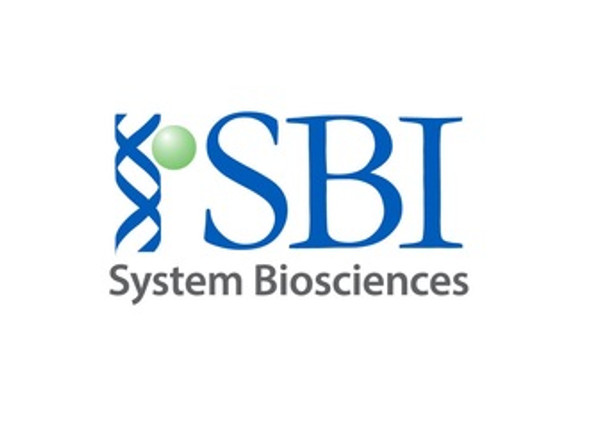System Biosciences
Cas9 Nickase: MSCV-hspCas9(D10A)-T2A-Puro SmartNickase Lentivector Plasmid
- SKU:
- CASLV220PA-1
- Availability:
- Usually Shipped in 5 Working Days
- Size:
- 10 ug
- Shipping Temperature:
- Blue Ice/ Dry Ice
Description
Cas9 Nickase: MSCV-hspCas9(D10A)-T2A-Puro SmartNickase Lentivector Plasmid. Cat# CASLV220PA. Supplier: SBI System Biosciences
- Conduct genome editing and engineering in difficult-to-transfect cell lines
- Stay more on-target with Cas9 nickase activity
- Drive Cas9 expression from the MSCV promoter, for high expression in hematopoietic and stem cells
- Perform in vivo engineering of model organisms
- Supports synthetic biology applications, gene- and cell-based therapy development, and genome-wide functional screening
Products

Overview

- Conduct genome editing and engineering in difficult-to-transfect cell lines
- Drive Cas9 expression from the MSCV promoter, for high expression in hematopoietic and stem cells
- Check transduction efficiencies with the GFP marker
- Perform in vivo engineering of model organisms
- Supports synthetic biology applications, gene- and cell-based therapy development, and genome-wide functional screening

How It Works
Genome engineering with CRISPR/Cas9
For general guidance on using CRISPR/Cas9 technology for genome engineering, take a look at our CRISPR/Cas9 tutorials as well as the following application notes:
CRISPR/Cas9 Basics
Through careful selection of the target sequence and design of a donor plasmid for homologous
recombination, you can achieve efficient and highly targeted genomic modification with CRISPR/Cas9.
The system

Cas9 protein—uses guide RNA (gRNA) to direct site-specific, double-strand DNA cleavage adjacent to a protospacer adapter motif (PAM) in the target DNA.
gRNA—RNA sequence that guides Cas9 to cleave a homologous region in the target genome. Efficient cleavage only where the gRNA homology is adjacent to a PAM.
PAM—protospacer adapter motif, NGG, is a target DNA sequence that spCas9 will cut upstream from if directed to by the gRNA.
The workflow at-a-glance
DESIGN: Select gRNA and HR donor plasmids. Choice of gRNA site and design of donor
plasmid determines whether the homologous recombination event results in a knock-out,
knock-in, edit, or tagging.
CONSTRUCT: Clone gRNA into all-in-one Cas9 vector. Clone 5’ and 3’ homology arms into HR
donor plasmid. If creating a knock-in, clone desired gene into HR donor.
CO-TRANSFECT or CO-INJECT: Introduce Cas9, gRNA, and HR Donors into the target cells
using co-transfection for plasmids, co-transduction for lentivirus, or co-injection for mRNAs.
SELECT/SCREEN: Select or screen for mutants and verify.
VALIDATE: Genotype or sequence putative mutants to verify single or biallelic conversion.


















![Cas9 Nickase: MSCV-hspCas9(D10A)-T2A-Puro SmartNickase Pre-Packaged Lentiviral Particles [>10^6 IFUs] Cas9 Nickase: MSCV-hspCas9(D10A)-T2A-Puro SmartNickase Pre-Packaged Lentiviral Particles [>10^6 IFUs]](https://cdn11.bigcommerce.com/s-i3n9sxgjum/images/stencil/590x590/products/12516/12780/sbi%2520system%2520biosciences_1633075021__00205.original__96364.1633076539.jpg?c=1)
![Cas9 Nickase: MSCV-hspCas9(D10A)-T2A-Puro SmartNickase Pre-Packaged Lentiviral Particles [>10^6 IFUs] Cas9 Nickase: MSCV-hspCas9(D10A)-T2A-Puro SmartNickase Pre-Packaged Lentiviral Particles [>10^6 IFUs]](https://cdn11.bigcommerce.com/s-i3n9sxgjum/images/stencil/590x590/products/12516/15553/CASLV225PA-1__70182.1638864794.png?c=1)

